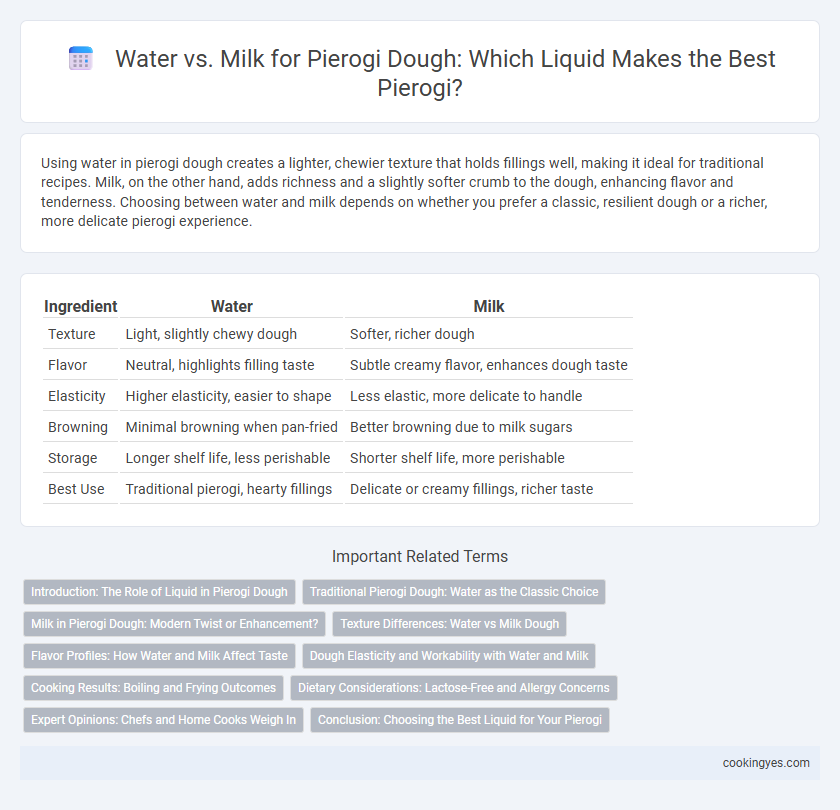Using water in pierogi dough creates a lighter, chewier texture that holds fillings well, making it ideal for traditional recipes. Milk, on the other hand, adds richness and a slightly softer crumb to the dough, enhancing flavor and tenderness. Choosing between water and milk depends on whether you prefer a classic, resilient dough or a richer, more delicate pierogi experience.
Table of Comparison
| Ingredient | Water | Milk |
|---|---|---|
| Texture | Light, slightly chewy dough | Softer, richer dough |
| Flavor | Neutral, highlights filling taste | Subtle creamy flavor, enhances dough taste |
| Elasticity | Higher elasticity, easier to shape | Less elastic, more delicate to handle |
| Browning | Minimal browning when pan-fried | Better browning due to milk sugars |
| Storage | Longer shelf life, less perishable | Shorter shelf life, more perishable |
| Best Use | Traditional pierogi, hearty fillings | Delicate or creamy fillings, richer taste |
Introduction: The Role of Liquid in Pierogi Dough
The choice between water and milk as the liquid component in pierogi dough significantly influences texture and flavor. Water produces a lighter, more tender dough while milk adds richness and a subtle creamy taste, enhancing the overall mouthfeel. Understanding this distinction allows for precise control over the pierogi's consistency and culinary character.
Traditional Pierogi Dough: Water as the Classic Choice
Traditional pierogi dough relies on water as the classic hydrating ingredient, offering a neutral flavor that highlights the filling's taste. Using water instead of milk results in a lighter, more elastic dough that is easier to roll and shape. This traditional approach preserves the authentic texture and consistency prized in Eastern European pierogi recipes.
Milk in Pierogi Dough: Modern Twist or Enhancement?
Using milk in pierogi dough provides a richer, softer texture compared to traditional water-based recipes, enhancing both flavor and pliability. Milk's natural fats and proteins contribute to a tender dough that browns more evenly when cooked, offering a modern twist on the classic pierogi. This slight dairy infusion elevates the overall mouthfeel and can complement a wider variety of fillings, appealing to contemporary palates seeking subtle creaminess.
Texture Differences: Water vs Milk Dough
Pierogi dough made with water results in a lighter, more elastic texture that is easier to roll and shape, creating tender dumplings with a delicate bite. Dough prepared with milk tends to be richer and slightly denser, yielding pierogi with a creamier mouthfeel and a softer, more pliable consistency. The choice between water and milk directly impacts the dough's moisture content and protein structure, influencing the final texture and overall eating experience.
Flavor Profiles: How Water and Milk Affect Taste
Using water in pierogi dough results in a lighter, more neutral flavor that allows the filling to stand out, preserving the traditional taste experience. Milk enriches the dough with a subtle sweetness and creaminess, adding depth and a tender texture that enhances the overall flavor profile. Choosing between water and milk depends on whether a delicate or richer dough is desired to complement the pierogi filling.
Dough Elasticity and Workability with Water and Milk
Using water for pierogi dough results in a firmer texture with higher elasticity, making the dough easier to stretch and less prone to tearing during shaping. Milk enhances dough softness and enriches flavor while slightly reducing elasticity, which can make the dough more pliable but potentially less resilient in handling. Choosing between water and milk depends on the desired balance of elasticity and workability, with water supporting stronger gluten development and milk providing tenderness.
Cooking Results: Boiling and Frying Outcomes
Using water in pierogi dough results in a lighter texture that holds shape well during boiling, producing tender, slightly chewy dumplings. Dough made with milk yields a richer, softer crust that enhances browning and crispiness when fried, creating a more flavorful exterior. Choosing water or milk directly influences the pierogi's texture and appearance after boiling and frying, tailored to preferred cooking outcomes.
Dietary Considerations: Lactose-Free and Allergy Concerns
Pierogi dough made with water is a preferred choice for those with lactose intolerance or milk allergies, ensuring the dish remains dairy-free and safe to consume. Using water instead of milk eliminates the risk of adverse reactions while maintaining a pliable and tender dough texture. For gluten-sensitive individuals, pairing water-based dough with gluten-free flour alternatives can further accommodate dietary restrictions.
Expert Opinions: Chefs and Home Cooks Weigh In
Chefs and home cooks debate the use of water versus milk in pierogi dough, with many experts favoring water for its ability to create a lighter, more pliable texture essential for traditional pierogi. Some artisans recommend milk to add richness and tenderness, resulting in a dough that is slightly softer and more flavorful. Ultimately, the choice depends on desired dough elasticity and flavor profile, with professional chefs often prioritizing water to maintain authenticity and home cooks experimenting with milk for enhanced taste.
Conclusion: Choosing the Best Liquid for Your Pierogi
Water creates a lighter, more tender pierogi dough that allows fillings to shine, while milk adds richness and a slightly denser texture, enhancing flavor complexity. For traditional pierogi, water is preferred to maintain the classic delicate chewiness, but milk can be used to achieve a softer, more flavorful dough. Ultimately, selecting water or milk depends on whether a lighter texture or richer taste is desired in the final pierogi.
Water vs Milk for Pierogi Dough Infographic

 cookingyes.com
cookingyes.com